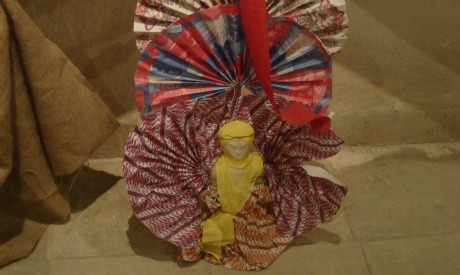
Mulid doll as displayed at the national folk dolls museum
photo by amira el noshokaty
Lots of colourful racks cover the sides of sweet shops and bakeries, with numerous horses and dolls wearing colourful garments. Traditional candy is everywhere on display, as today marks the birthday of the Prophet Mohammed.
But that was not the case in Fatimid Egypt. unlike the current plastic dolls, the moulid doll was once yet another symbol of the multicultural layers of Egypt.
Moulids (carnivals of faith) have long been interwoven in ancient Egyptian history. As Mcpherson puts it in his master-piece "The Moulids of Egypt', it was the Fatimid, who ruled Egypt during the 10th to 12th century and adopted the moulid festivities and gave them legitimacy. Aiming to make their new capital a protectorate of Islamic sanctuaries, the Fatimids celebrated the moulids, with special emphasis on those related to the Prophet Mohammed and his descendants.
The festivals that are affiliated with the birthdays of Sufi sheikhs or saints have always embodied secular and religious traits. Among the secular aspects are parades, candy, street carnivals and numerous candy figurines that include candy horses for boys and dolls for girls.
In Abdel Ghani El Nabawi’s book, Moulid Doll, he delves into the philosophy behind the doll, explaining that it could be derived from the idea of Eve, who was born to give life. It is also associated with the source of beauty and kindness, fertility and youth. As he puts it, “it stands for one entertaining chapter of human history and is a symbol of imagination.”
Starting with the moulid doll’s attire, one can see that it reflects the costumes of women during the Fatimid era in Egypt. Since the Fatimids and Abbasids were influenced by the Persians, you can also detect a distinct Persian influence in the design.
The head-turban, narrow waistline, layers of clothes and an excess of frills are typical Fatimid clothes.
The tight vest that fans out into a generous A-shaped dress that covers the doll’s ivory body is a typical Mamluk costume. The colourful paper fans clasped to her back are derived from the feathered fans used by the caliphate. The number of fans adds to the value of the doll. The corsage reflects typical peasants’ clothes and the shimmering golden and silver paper necklaces echo the traditional peasant gold necklace, known as kerdan.
The generous black kohl (eye liner) that outlines her eyes and brows is a typical ancient Egyptian trend. Also the excess pink blush is attributed to the makeup style of the ancient Egyptians.
On a corresponding note, the moulding of the candy doll is equally fascinating.
First the indigenous artists would engrave the shape of the doll on a wooden mould that splits into two identical sides. Then they’d add large amounts of sugar, mix it with water and lemon and leave on the stove to boil. The mixture is poured into the wooden mould and left to dry. The end result is an ivory figurine of a doll, with narrow waistline and a cylinder hollow body to ensure stability. The doll is then ready for decoration.
Unfortunately nowadays, the plastic moulid doll dominates the market. It can be quite difficult to purchase the authentic one and we advise you to look for it in popular districts.
Many happy returns!
Short link: